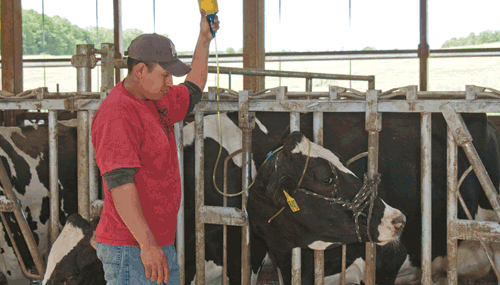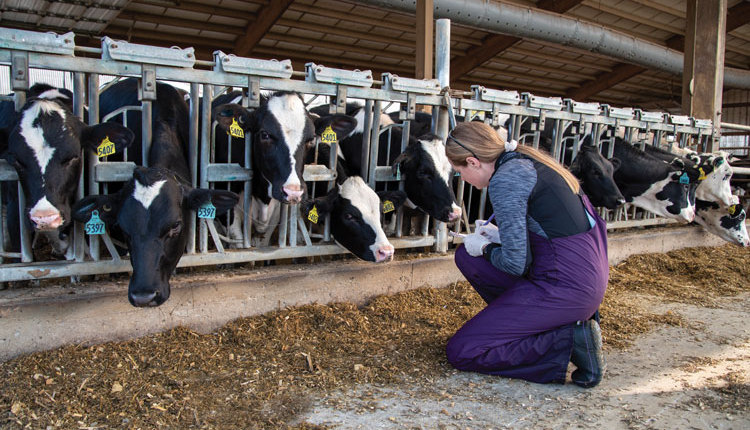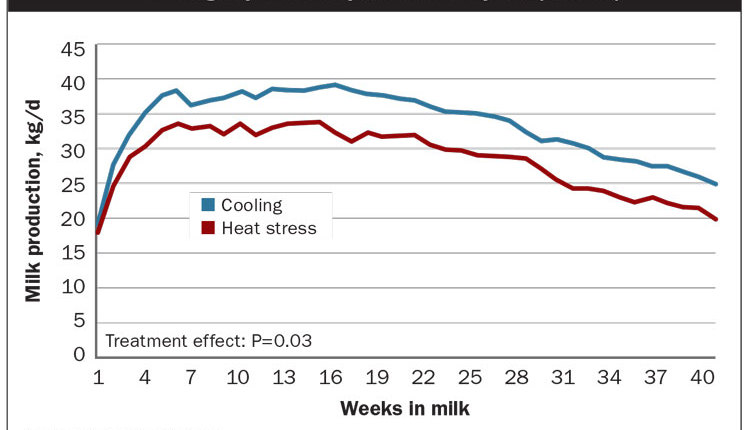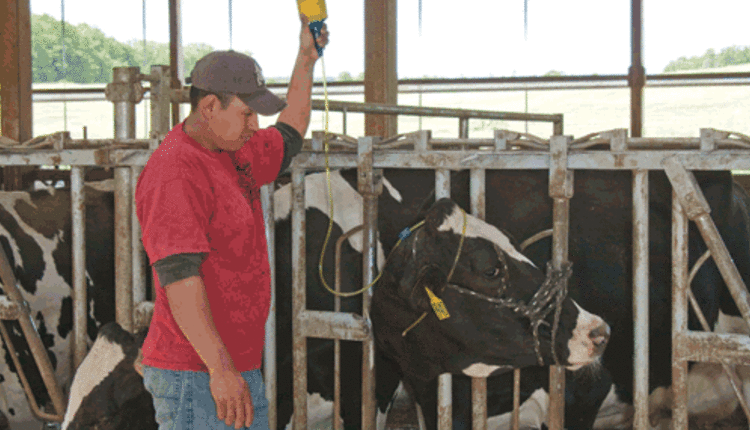The author is owner of Country Roads Veterinary Services, Ashland, Ohio. This article is part of a series being prepared in cooperation with the American Association of Bovine Practitioners.

We are all part of the food industry . . . producers, veterinarians, extension personnel, government regulators, academic researchers, feed distributors, and animal health companies. Milk and meat are our products, but we work with the animals . . . living beings that require care and management to optimize their production, keep them healthy, and ensure their welfare. Our tools include medications to enhance their effectiveness and the safety of the food they produce.
Many years ago, if there was a sick animal on the farm, the veterinarian was called to treat that animal, and then follow-up instructions were given to the owner. Today, owners and employees often are treating animals without direct veterinary involvement. Although this does reduce veterinary expense, your veterinarian also wants you to diagnose and treat the condition in that individual animal properly when he/she is not attending to that animal personally. Therefore, the primary objective of the treatment protocol is to help guide your farm's team in treating health conditions in cattle properly under the indirect guidance of the prescribing veterinarian.
Treatment guidelines can help to improve the success of treatment, eliminate decision making by employees, and improve animal welfare by ensuring that sick animals are receiving the proper treatment in a timely manner. Treatment protocols also can help to eliminate the risk of a violative meat or milk residue.
Many medications that are used on the farm are used in an "extra-label" manner. Examples would include medications that are used at a different dose, in a different species or type of animal, or in a different route than is written on the label. Many producers are not aware that using drugs in an extra-label manner is allowed only under the guidance of the prescribing veterinarian. Having a treatment protocol on your farm ensures that your operation is in compliance with federal rules pertaining to medication use in food animals.
A basic treatment protocol should discuss:
Examples of conditions that may be included in a treatment protocol include milk fever, ketosis, mastitis, metritis, pneumonia, bovine respiratory disease, scours, and lameness.
Veterinarians want producers to take the initiative and treat animals and conditions under the guidelines of the treatment protocol. However, we also want you to call for help when a more complex condition requires examination and treatment by a trained professional medical doctor.
Your treatment protocol should be written and easily accessible to refer to during examination and treatment. The treatment protocol should have your farm name and the veterinarians name clearly identified.
The veterinarian who is prescribing the drugs on your farm should write your treatment protocols working with the management team of your farm. Ultimately, the veterinarian who prescribes the medication is accountable for the responsible use of that medication on your farm. If you use more than one veterinarian, then make sure that you are following the guidelines of the veterinarian who provided that medication. Remember that federal regulations require that producers use the medication as prescribed or, if they are used in an extra-label manner, they are working under the guidelines of the prescribing veterinarian.
Unfortunately, many people use the medication in a manner that is not what the prescribing veterinarian recommends. Examples would include using medications purchased from over-the-counter sources in an extra-label manner, using compounded medications that are not approved for cattle, and using medications based on the advice of nonveterinarians. This puts your farm at risk of residue violations and treatment failures, and it also puts your veterinarian at risk because he or she is the one who ultimately is responsible for the proper use of medication on your farm.
Having a written treatment protocol is important, but following the guidelines and reviewing them is important, as well. Your veterinarian wants the treatment protocols to be useful to your farm and successful in returning sick animals back to health and production. Treatment protocols will fail if they are not followed or "procedural drift" occurs. Procedural drift is the process by which employees or owners "adjust" the protocol without consulting their veterinarian. If you believe that a treatment protocol is not working for your farm, discuss it with your veterinarian right away.
In order to assist your veterinarian in evaluating your treatment protocol, it is best to have written treatment records. Your vet will want to make sure you are identifying the proper condition, as well as reviewing how you are treating it. It also is helpful to monitor the outcome of your treatments. Did the cow get better? What percent returned to production? What percent failed and were culled or died?
Sample treatment protocol for milk fever
Signs/symptoms for recently fresh cow*:
110125_53

We are all part of the food industry . . . producers, veterinarians, extension personnel, government regulators, academic researchers, feed distributors, and animal health companies. Milk and meat are our products, but we work with the animals . . . living beings that require care and management to optimize their production, keep them healthy, and ensure their welfare. Our tools include medications to enhance their effectiveness and the safety of the food they produce.
Many years ago, if there was a sick animal on the farm, the veterinarian was called to treat that animal, and then follow-up instructions were given to the owner. Today, owners and employees often are treating animals without direct veterinary involvement. Although this does reduce veterinary expense, your veterinarian also wants you to diagnose and treat the condition in that individual animal properly when he/she is not attending to that animal personally. Therefore, the primary objective of the treatment protocol is to help guide your farm's team in treating health conditions in cattle properly under the indirect guidance of the prescribing veterinarian.
Treatment guidelines can help to improve the success of treatment, eliminate decision making by employees, and improve animal welfare by ensuring that sick animals are receiving the proper treatment in a timely manner. Treatment protocols also can help to eliminate the risk of a violative meat or milk residue.
Many medications that are used on the farm are used in an "extra-label" manner. Examples would include medications that are used at a different dose, in a different species or type of animal, or in a different route than is written on the label. Many producers are not aware that using drugs in an extra-label manner is allowed only under the guidance of the prescribing veterinarian. Having a treatment protocol on your farm ensures that your operation is in compliance with federal rules pertaining to medication use in food animals.
A basic treatment protocol should discuss:
- Who is responsible for treatments.
- Which group of animals is being treated - preweaned calves, heifers, or cows. Medications are labeled for different groups.
- How to perform a basic exam.
- What are the common signs of the disease.
- What treatments should be administered. Included would be the name of the medication, the dose, the route administered, and frequency of administration.
- What are the milk and meat withholds.
Examples of conditions that may be included in a treatment protocol include milk fever, ketosis, mastitis, metritis, pneumonia, bovine respiratory disease, scours, and lameness.
Veterinarians want producers to take the initiative and treat animals and conditions under the guidelines of the treatment protocol. However, we also want you to call for help when a more complex condition requires examination and treatment by a trained professional medical doctor.
Your treatment protocol should be written and easily accessible to refer to during examination and treatment. The treatment protocol should have your farm name and the veterinarians name clearly identified.
The veterinarian who is prescribing the drugs on your farm should write your treatment protocols working with the management team of your farm. Ultimately, the veterinarian who prescribes the medication is accountable for the responsible use of that medication on your farm. If you use more than one veterinarian, then make sure that you are following the guidelines of the veterinarian who provided that medication. Remember that federal regulations require that producers use the medication as prescribed or, if they are used in an extra-label manner, they are working under the guidelines of the prescribing veterinarian.
Unfortunately, many people use the medication in a manner that is not what the prescribing veterinarian recommends. Examples would include using medications purchased from over-the-counter sources in an extra-label manner, using compounded medications that are not approved for cattle, and using medications based on the advice of nonveterinarians. This puts your farm at risk of residue violations and treatment failures, and it also puts your veterinarian at risk because he or she is the one who ultimately is responsible for the proper use of medication on your farm.
Having a written treatment protocol is important, but following the guidelines and reviewing them is important, as well. Your veterinarian wants the treatment protocols to be useful to your farm and successful in returning sick animals back to health and production. Treatment protocols will fail if they are not followed or "procedural drift" occurs. Procedural drift is the process by which employees or owners "adjust" the protocol without consulting their veterinarian. If you believe that a treatment protocol is not working for your farm, discuss it with your veterinarian right away.
In order to assist your veterinarian in evaluating your treatment protocol, it is best to have written treatment records. Your vet will want to make sure you are identifying the proper condition, as well as reviewing how you are treating it. It also is helpful to monitor the outcome of your treatments. Did the cow get better? What percent returned to production? What percent failed and were culled or died?
Sample treatment protocol for milk fever
Signs/symptoms for recently fresh cow*:
- Cow down or wobbly/weak
- Cold ears, tail, skin
- Neck held with S-curve
- No manure or urinations, constipation
- Usually second lactation and older cows
- Warm 500mL bottle of calcium in a bucket of hot water
- Administer calcium (calcium gluconate or CMPK) slowly IV . . . only give one bottle IV
- If cow down, also administer one bottle calcium under skin OR give oral calcium source (liquid calcium, calcium paste tube, or calcium bolus)
- Make sure cow is on deep comfortable bedded pack with good footing
- If down on concrete or uncomfortable area, give flunixin meglumine 10 to 15 cc IV for pain
- • If no response in 4 to 6 hours, blood test for calcium, magnesium, phosphorous, and electrolyte levels
- • Re-administer treatment if indicated, or contact veterinarian
110125_53









